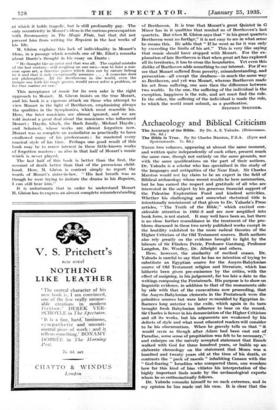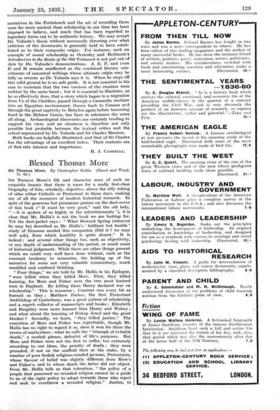Archaeology and Biblical Criticism
The Bible is True. By Sir Charles Marston, F.S.A. (Eyre and Spottiswoode. 7s. 6d.) THESE two volumes, appearing at almost the same moment, and written quite independently of each other, present much the same case, though not entirely on the same grounds, nor with the same qualifications on the part of their authors. Dr. Yahuda is a scholar who has specialized in the study of the languages and antiquities of the Near East. Sir Charles Marston would not lay claim to be an expert in the field of Biblical archaeology whose recent results he here summarizes, but he has earned the respect and gratitude of all who are interested in the subject by his generous financial support of the Palestine Exploration Fund and kindred activities. Whether his challenging and somewhat rhetorical title is intentionally reminiscent of that given to Dr. Yahuda's Press articles, " The Truth of the Bible," which excited con- siderable attention in 1932-3 and are now amplified into book form, is not stated. It may well have been so, but there is no close further resemblance in the treatment of the pro- blems discussed in these two newly published works except in the hostility exhibited to the more radical theories of the Higher Criticism), of the Old Testament sources. Both authors also rely greatly on the evidence brought to light by the labours of Sir Flinders Petrie, Professor Garstang, Professor Langdon, Dr. Woolley, Dr. Albright and others.
Here, however, the similarity of method ceases. Dr.
Yahuda is careful to say that he has no intention of trying to substitute an Egyptian source for the Assyro-Babylonian source of Old Testament religion and literature, which has hitherto been given pre-eminence by the critics, with the effect of assigning, in his judgement, far too late a date to the writings composing the Pentateuch. His purpose is to show on linguistic evidence, in addition to that of the monuments side by side with that of the excavations now proceeding, that the Assyro-Babylonian elements in the Pentateuch were the primitive sources but were later re-moulded by Egyptian in- fluences long anterior to the exile, which again in its turn brought fresh Babylonian influence to bear on the record. Sir Charles is fiercer in his denunciation of the Higher Criticism and all its works, but his arguments are weakened by his defects of style and what most educated readers will consider to be his obscurantism. When he gravely tells us that " it would ECM as though after Adam had been cast out of Paradise, some sense of propitiation was felt to be necessary," • and enlarges on the naively accepted statement that Enoch- walked with God for three hundred years, or builds up an. elaborate chronology on the statement that Moses was a. hundred and twenty years old at the time of his death, or contrasts the " pack of rascals " inhabiting Canaan with the " God-fearing " Israelites who conquered them, one wonders how far this kind of bias vitiates his interpretation of the highly important finds made by- the archaeological experts whom he so enthusiastically follows.
Dr. Yahuda commits himself to no such extremes, and in my opinion he has made out his case. It is dear that the narratives in the Pentateuch and the art of recording them were far more ancient than scholarship in our time has been disposed to believe, and much that has been regarded as legendary turns out to be authentic history. We may accept Dr. Yahuda's thesis without necessarily throwing over what criticism of the documents is generally held to have estab- lished as to their composite origin. For instance, such an example of sound scholarship as Oesterley and Robinson's Introdualon to the Books of the Old Testament is not put out of date by Dr. Yahuda's demonstrations. J, E, P, and even
D and H remain unaffected as the combined literary con- stituents of canonical writings whose ultimate origin may be. fully as remote as Dr. Yahuda says it is. When he steps off this solid ground he is no safe guide. It is not essential to his case to maintain that the two versions of the creation were written by the same hand ; but it is essential to illustrate, as he so effectively does, that a story which began in a migration from Ur of the Chaldees, passed through a Canaanite medium into an Egyptian environment, thence back to Canaan and through the great captivity to Babylon again before becoming fixed in the Hebrew Canon, has been in substance the same. all along. Archaeological discoveries are certainly tending to support his view, and an eirenicon is therefore not only possible but probable between the textual critics and the school represented by Dr. Yahuda and Sir Charles Marston.
Both books are helpfully illustrated, and that of Sir Charles has the advantage of an excellent index. Their contents are of first-rate interest and importance.
R. J. CAMPBELL.















































 Previous page
Previous page